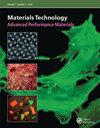Green synthesis of biofabricated silver nanoparticles from Syzygium aromaticum seeds: spectral characterization and evaluation of its anti-mycobacterial activity, cytotoxicity assessment on zebrafish embryo and Artemia salina
IF 3.7
4区 材料科学
Q3 MATERIALS SCIENCE, MULTIDISCIPLINARY
引用次数: 0
Abstract
The lack of a viable vaccine and the emergence of novel Mycobacterium tuberculosis (MTB) strains that are particularly resistant to treatments, presage a complicated future situation. Biosynthesized nanomaterials are currently proving to be a viable antibacterial therapeutic option, including for MTB infection treatment. The goal of this work is to synthesize silver nanoparticles (AgNPs) from Syzygium aromaticum seeds and investigate their antimicrobial, anti-tubercular, and cytotoxic properties using zebrafish embryos and Artemia salina. The UV spectrophotometer, SEM-EDAX, TEM and FTIR measurements were used to characterize the AgNPs. Antibacterial activity was performed against S. aureus, P. aeruginosa, E. coli and K. pneumoniae and exhibited potential inhibitory activity towards the bacterial cultures. The MABA assay was used to investigate the anti-mycobacterial activity, and the AgNPs showed the highest percentage of inhibition in both test concentrations (250 and 500 µg/ml).绿色合成香薷种子生物合成纳米银:光谱表征、抗分枝杆菌活性评价、斑马鱼胚胎和盐蒿细胞毒性评价
缺乏可行的疫苗以及对治疗特别具有耐药性的新型结核分枝杆菌(MTB)菌株的出现预示着未来的复杂情况。生物合成纳米材料目前被证明是一种可行的抗菌治疗选择,包括结核分枝杆菌感染的治疗。本研究的目的是利用斑马鱼胚胎和盐蒿(Artemia salina)合成银纳米颗粒(AgNPs),并研究其抗菌、抗结核和细胞毒性。采用紫外分光光度计、SEM-EDAX、TEM和FTIR对AgNPs进行了表征。对金黄色葡萄球菌、铜绿假单胞菌、大肠杆菌和肺炎克雷伯菌均有抑菌活性,并对细菌培养物表现出潜在的抑制活性。用MABA检测抗分枝杆菌活性,结果表明,AgNPs在250µg/ml和500µg/ml两种浓度下的抑制率最高。
本文章由计算机程序翻译,如有差异,请以英文原文为准。
求助全文
约1分钟内获得全文
求助全文
来源期刊

Materials Technology
工程技术-材料科学:综合
CiteScore
6.00
自引率
9.70%
发文量
105
审稿时长
8.7 months
期刊介绍:
Materials Technology: Advanced Performance Materials provides an international medium for the communication of progress in the field of functional materials (advanced materials in which composition, structure and surface are functionalised to confer specific, applications-oriented properties). The focus is on materials for biomedical, electronic, photonic and energy applications. Contributions should address the physical, chemical, or engineering sciences that underpin the design and application of these materials. The scientific and engineering aspects may include processing and structural characterisation from the micro- to nanoscale to achieve specific functionality.
 求助内容:
求助内容: 应助结果提醒方式:
应助结果提醒方式:


